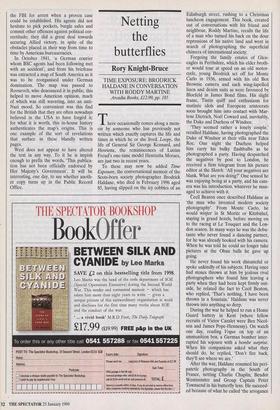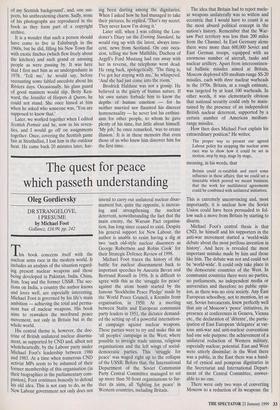Netting the butterflies
Rory Knight-Bruce
TIME EXPOSURE: BRODRICK HALDANE IN CONVERSATION WITH RODDY MARTINE Arcadia Books, £12.99, pp. 185 There occasionally comes along a mem- oir by someone who has previously not written which exactly captures the life and times in which he or she lived. Loopy, the life of General Sir George Kennard, and Henrietta, the reminiscences of Lucian Freud's one-time model Henrietta Moraes, are just two in recent years.
To these may now be added Time Exposure, the conversational memoir of the Scots-born society photographer Brodrick Haldane, who died in February 1996 aged 85, having slipped on the icy cobbles of an Edinburgh street, rushing to a Christmas luncheon engagement. This book, created out of conversations with his friend and neighbour, Roddy Martine, recalls the life of a man who turned his back on the dour repressions of his native land and went in search of photographing the superficial chimera of international society.
Forgoing the family estates of Glen- eagles in Perthshire, which his elder broth- er would tour at speed on an old motor- cycle, young Brodrick set off for Monte Carlo in 1936, armed with his old Box Brownie camera and such wing-lapelled linen and denim suits as were favoured by Bloefeld in James Bond films. His slight frame, Tintin quiff and enthusiasm for matinee idols and European aristocrats soon brought him into contact with Mar- lene Dietrich, Nod. Coward and, inevitably, the Duke and Duchess of Windsor.
`They seemed rather a lonely couple,' recalled Haldane, having photographed the Duke of Windsor at their villa near Eden Roc. One night the Duchess helped him carry his bulky flashbulbs as he photographed a party. Having despatched the negatives by post to London, he received a firm telegram from his picture editor at the Sketch: 'All your negatives are blank. What are you doing?' One sensed he was enjoying being at a party, and his cam- era was his introduction, whatever he man- aged to achieve with it.
Cecil Beaton once described Haldane as `the man who invented modern society photography'. From Monte Carlo, he would winter in St Moritz or Kitzbiihel, staying in grand hotels, before moving on to the racing at Le Touquet and the Lon- don season. In many ways he was the debu- tante who never found a dancing partner, for he was already booked with his camera. When he was told he could no longer take pictures at the Oban balls he gave up going.
He never found his work distasteful or spoke unkindly of his subjects. Having once had stones thrown at him by jealous rival photographers who found him leaving a party when they had been kept firmly out- side, he related the fact to Cecil Beaton, who replied, 'That's nothing, I have been thrown in a fountain.' Haldane was never thrown into anything so deep.
During the war he helped to run a Home Guard battery in Kent (where fellow recruits of Victor Cazalet were Ben Nicol- son and James Pope-Hennessy). On watch one day, reading Vogue on top of an ammunition box, a German bomber inter- rupted his sojourn with a bombe surprise. When his companions asked what they should do, he replied, 'Don't fire back, they'll see where we are.'
After the war, Haldane resumed his peri- patetic photography in the South of France, netting Charlie Chaplin, Bendor Westminster and Group Captain Peter Townsend in his butterfly lens. He succeed- ed because of what he called 'the arrogance of my Scottish background', and, one sus- pects, his unthreatening charm. Sadly, none of his photographs are reproduced in the book as they form part of a copyright archive.
It is a wonder that such a person should have come to live in Edinburgh in the 1960s, but he did, filling his New Town flat with exotic finches (which flew freely about the kitchen) and such grand or amusing people as were passing by. It was here that I first met him as an undergraduate in 1978. 'Tell me,' he would say, before recounting some fabled anecdote about his Riviera days. Occasionally, his glass guard of good manners would slip. Betty Ken- ward, the Jennifer of Harpers & Queen, he could not stand. She once hissed at him when he asked who someone was, 'You are supposed to know that.'
Later, we worked together when I edited Scottish Portrait and he, now in his seven- ties, and I would go off on assignments together. Once, covering the Scottish game fair at Strathallan, I lost him in the outdoor heat. He came back 20 minutes later, hav- ing been darting among the dignitaries. When I asked how he had managed to take their pictures, he replied, 'That's my secret. They never know I'm doing it.'
Later still, when I was editing the Lon- doner's Diary on the Evening Standard, he would ring up with the latest, always inno- cent, news from Scotland. On one occa- sion, telling me how Mathilda, Duchess of Argyll's Ford Mustang had run away with her in reverse, the telephone went dead. He rang back, apologetically. 'The thing is, I've got her staying with me,' he whispered. `And she had just come into the room.'
Brodrick Haldane was not a gossip. He believed in the gaiety of human nature. If his own nature forbade him to know the depths of human emotion — for he neither married nor flaunted his discreet homosexuality — he never lost his enthusi- asm for other people, to whom he gave plenty of his time, but little about himself. `My job,' he once remarked, 'was to create illusion.' It is in these memoirs that even those of us who knew him discover him for the first time.



























































 Previous page
Previous page